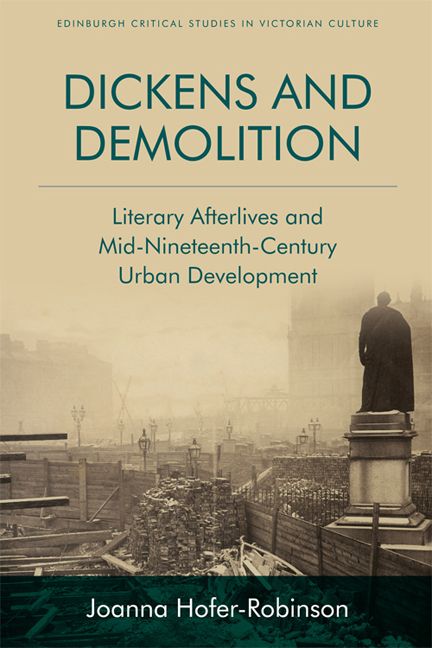Book contents
- Frontmatter
- Contents
- List of Illustration
- Acknowledgements
- Series Editor’s Preface
- Abbreviations and a Note on Editions
- Dedication
- Introduction
- 1 Charles Dickens and Metropolitan Improvements
- 2 Sets and the City: Staging London and Oliver Twist
- 3 Dickensian Afterlives and the Demolition of Field Lane
- 4 Paperwork and Philanthropy: Dickens’s Involvement in Metropolitan Improvement
- 5 From Sanit ary Reform to Cultural Memory: The Case of Jacob’s Island
- Coda
- Archival Sources and a Note on Method
- Select Bibliography
- Index
- Plate Section
3 - Dickensian Afterlives and the Demolition of Field Lane
Published online by Cambridge University Press: 29 April 2021
- Frontmatter
- Contents
- List of Illustration
- Acknowledgements
- Series Editor’s Preface
- Abbreviations and a Note on Editions
- Dedication
- Introduction
- 1 Charles Dickens and Metropolitan Improvements
- 2 Sets and the City: Staging London and Oliver Twist
- 3 Dickensian Afterlives and the Demolition of Field Lane
- 4 Paperwork and Philanthropy: Dickens’s Involvement in Metropolitan Improvement
- 5 From Sanit ary Reform to Cultural Memory: The Case of Jacob’s Island
- Coda
- Archival Sources and a Note on Method
- Select Bibliography
- Index
- Plate Section
Summary
Field Lane was hidden in plain sight. Centrally located in the heart of London but still obscure, it was a confined and dilapidated byway ‘too narrow for vehicles to use’, which led north off the busy thoroughfare of Holborn Hill to meet Saffron Hill. Field Lane was a gateway to a network of labyrinthine slum streets and overcrowded courts. However, the space also prevented outsiders from accessing these areas easily, as the trade carried out in the street obstructed direct paths of communication. Field Lane was closely associated with the traffic in stolen goods and second-hand clothes. A pedestrian's progress would have been hindered by stalls selling these wares, and clear lines of sight veiled by shop awnings bearing rows of fluttering handkerchiefs. This made monitoring or policing Field Lane's supposed criminal population difficult, particularly given the sparse resources of metropolitan police forces in the early nineteenth century. Until its partial demolition opened the remaining side of the street up for the observation of passers-by, shops with seedy reputations and brothels thrived among its closely packed tenements. Fearful of assaults upon their persons and property, some wealthier people were afraid to enter Field Lane.
Dickens responded to Field Lane's already iniquitous reputation when he decided to locate Fagin's den in this area in Oliver Twist (1837–9). The street was so notorious it could be used as a byword for urban danger prior to its widely popularised association with Fagin and Bill Sikes. For instance, detailing the disruptive conduct of several young boys at a crowded fair in 1820, the Morning Post comments sardonically, ‘[t]hey call themselves the “youths of the metropolis”, we believe; but from their appearance, we should suspect them to be the youths of St Giles’s, Field-lane, and Saffron-hill’. Listing Field Lane alongside other infamous slums, the article signals that these areas were perceived by many to be the worst in London, and were imaginatively connected with rough, potentially violent, behaviour. Field Lane's association with threatening individuals was reinforced repeatedly in the press.
- Type
- Chapter
- Information
- Dickens and DemolitionLiterary Afterlives and Mid-Nineteenth Century Urban Development, pp. 91 - 129Publisher: Edinburgh University PressPrint publication year: 2018

